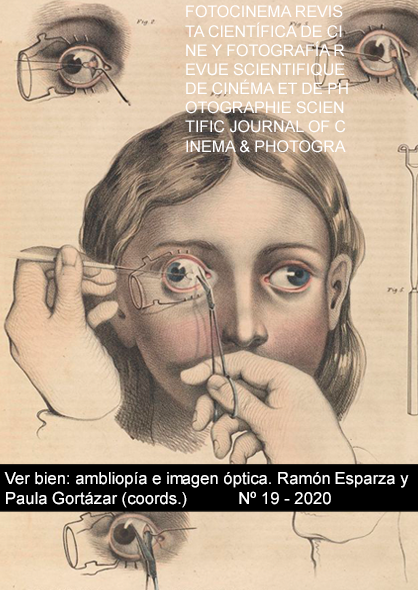The incomplete vision. Halfway seeing as an axis for artistic production
DOI:
https://doi.org/10.24310/Fotocinema.2019.v2i19.6645Keywords:
Amblyopia, “Hemivision”, Partial Vision, Visual Interruption, Deficiency, DismantlingAbstract
Based on the amblyopia logic, we’ll study artistic images (photography, video, installation) which go representative or materially without a certain amount of their surface. This gives room to a kind of “hemivision” which finds a balance between a correct vision and an insufficient one in several levels. As a result, it relates directly to pathological optics. Thanks to this way of seeing, and also of creating, one part of recognizable reality coexists with another one, which is voided in different ways. Thus, deficiency is presented as an alternative mode of dealing with the visible, where lack of definition is neither hidden nor corrected, but it is assumed and promoted as a way of seeing other things or as a different manner of seeing. In this case, the aim is not seeing better, but assimilating the limits of the perceivable and working productively from that point within the artistic context. All this questions reality from a perspective which admits both sensitive and expressible failures, which presents it as contingent and which address the real given its implicit imperfection. Far from raising difficulties, these aspects are potentiated by certain artistic practices, where they appear as qualifying elements, generating senses and modes of making world.
Downloads
Metrics
Publication Facts
Reviewer profiles N/A
Author statements
Indexed in
-
—
- Academic society
- N/A
- Publisher
- Universidad de Málaga
References
Beller, J. (1994). Cinema, Capital of the Twentieth Century. Postmodern Culture, vol. 4, nº3. http://pmc.iath.virginia.edu/text-only/issue.594/beller.594
Bellour, R. (2002). L’Entre-Images. Photo. Cinéma. Vidéo. Paris: Différence. Benjamin, W. (2008). Obras. Libro I, vol. 2. Madrid: Abada.
Benjamin, W. (2010). Obras. Libro IV, vol. 1. Madrid: Abada.
Castellano, T. (2013). Ver o no ver. Esa es una de las cuestiones. Re-visiones, nº3, 1-12 http://www.re-visiones.net/anteriores/spip.php%3Farticle80.html
Castellano, T. (2018). Derivas de la pantalla y “cultura invisual” (una propuesta de creación artística para no iniciados). En Murillo, V., Resano, JC. & Ramos, N. (coords.), Educación artística hoy. El reto en la sociedad de la imagen (pp. 31-52). Zaragoza: Prensas de la Universidad de Zaragoza.
Crary, J. (2015). 24/7. El capitalismo al asalto del sueño. Barcelona: Ariel.
Deleuze, G. & Guattari, F. (2006). Mil mesetas. Capitalismo y esquizofrenia. Valencia: Pre-textos.
Déotte, J. L. (2004). L’époque des appareils. París: Lignes & Manifestos.
Didi-Huberman, G. (2004). Imágenes pese a todo. Memoria visual del holocausto. Barcelona: Paidós.
Didi-Huberman, G. (2006). Lo que vemos, lo que nos mira. Buenos Aires: Manantial. Barcelona: Paidós.
Fu?zesséry, S. & Simay, P. (Eds.). (2008). Le choc des métropoles. Simmel, Kracauer, Benjamin. Paris: Éditions de l’éclat.
Han, BC. (2012). La sociedad del cansancio. Barcelona: Herder.
Hernández-Navarro, M. Á. (2007). El archivo escotómico de la Modernidad. Pequeños pasos para una cartografía de la visión. Alcobendas: Ayuntamiento de Alcobendas.
Hustvedt, S. (2009) Truth and Rightness, Heinzelmann, M. (Ed.), Gerhard Richter. Overpainted Photographs [catálogo de exposición] (pp. 73-78). Stuttgart: Hatje Cantz.
Jay, M. (2007). Ojos abatidos. La denigración de la visión en el pensamiento francés del siglo XX. Tres Cantos (Madrid): Akal.
Kracauer, S. (2006). Estética sin territorio. Murcia: Colegio Oficial de Aparejadores y Arquitectos Técnicos, Fundación Caja Murcia.
Lacan, J. (1977). Jacques Lacan. Los cuatro conceptos fundamentales del psicoanálisis. Seminario XI. Barcelona: Barral.
Lacan, J. (1983). El seminario de Jacques Lacan. Libro 2. El yo en la teoría de Freud y en la técnica psicoanalítica, 1954-1955. Barcelona: Paidós.
Rewald, J. (1978). Paul Cézanne, correspondance. Paris: Grasset.
Rodschenko, A. (1989) [1928]. Downright ignorance or a mean trick?, Phillips, C. (Ed.), Photography in the Modern Era (pp. 245-248). Nueva York: The Metropolitan Museum of Art/Aperture.
Ross, C., (2001a). Vision and Insufficiency at the Turn of the Millenium. Rosemarie Trockel distracted eye. October, nº 96, 86-110.
Ross, C., (2001b). The Insufficiency of the Performative: Video Art at the Turn of the Millenium. The Body and Technology. Art Journal, vol. 60, nº 1, 28-33.
Ross, C., (2006). The Aesthetics of Disengagement. Contemporary Art and Depression. Minneapolis: University of Minnesota.
Sacks, O. (2009). El hombre que confundió a su mujer con un sombrero. Barcelona: Anagrama.
Žižek, S. (1989). The Sublime Object of Ideology. Londres: Verso.
Žižek, S. (2000). Mirando al sesgo. Una introducción a Jacques Lacan a través de la cultura popular. Buenos Aires: Paidós.
Downloads
Published
How to Cite
Issue
Section
License
All contents published in Fotocinema Revista científica de cine y fotografía are protected under the Creative Commons Attribution-NonCommercial-ShareAlike 4.0 International (CC BY-NC-SA 4.0) license. All about this license is available in the following link: <http://creativecommons.org/licenses/by-nc-sa/4.0>
Users can copy, use, redistribute, share and exhibit publicly as long as:
- The original source and authorship of the material are cited (Journal, Publisher and URL of the work).
- It is not used for comercial purposes.
- The existence of the license and its especifications are mentioned.
There are two sets of authors’ rights: moral and property rights. Moral rights are perpetual prerogatives, unrenounceable, not-transferable, unalienable, imprescriptible and inembargable. According to authors’ rights legislation, Fotocinema. Revista científica de cine y fotografía recognizes and respects authors moral rights, as well as the ownership of property rights, which will be transferred to University of Malaga in open access. The property rights are referred to the benefits that are gained by the use or the dissemination of works. Fotocinema. Revista científica de cine y fotografía is published in an open access form and it is exclusively licenced by any means for doing or authorising distribution, dissemination, reproduction, , adaptation, translation or arrangement of works.
Authors are responsable for obtaining the necessary permission to use copyrighted images.














13.png)



